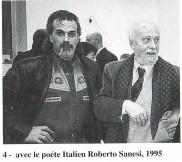
|
In ancient Greece the artist was called demiurgòs whereas in Sansktritic India he was a karaka, that is, an author in the original sense of auctor: the creator of a new thing. Now, to create means giving life to what did not exist before, inventing outside and beyond any scheme. The creator starts out from the tabula rasa and consequently rejects whatever previously established order. Whether he wishes or not, the individual involved in a creating activity is an anarchist. Anarchy is the artist's vital condition, in the same way movement is the way that matter exists. In the same way that matter is the dimension of movement, the artist is the dimension of the anarchic, and vice versa. "It is a man or a stone or a tree that will begin the fourth canto": this line by Lautréamont seems to want to inspire the creative and metamorphic pulsion which imbues the worldly factory invented by Max Hamlet. With the maximum naturalness his characters become men or women with the faces of animals, insects or vegetal elements. The effort which Federico Garcia Lorca imagined "of the horse in order to be a dog… of the dog in order to be a swallow… of the swallow in order to be a bee… of the bee in order to be a horse" here vanishes insofar as these shiftings of identity motivated by the need to lay bear the paradoxes, the dissolution and the violence of society, seem to be both right and
|
necessary. Franco Russoli was the first to point out that the ideal inspiration of Hamlet's critical and satirical exercise was to be looked for in Goya's caprichos (caprices). The protest against opulent society, its perverse plychological and information mechanisms, feeds Max Hamlet's imaginary. His depictions draw inspiration from the sophisticated and spoiled environment of the jet society and uppermiddle classes of Milan, Miami, Barcelona or Los Angeles. His language filters and newly elaborates the stimuli of Surrealism with particular attention paid to the principle of enstrangement dear to Max Ernst in his collages of the 1930's, of Magritte's mysterious atmosphere and of Savinio's characters, without forgetting the chronicle residues in Warhol's silk-screen transfers and the comic's stylistic characteristics. Contrary to Roy Lichtenstein's neutrality, Max Hamlet has understood how to charge the comic discussion "with psychological and moral implications", as Giorgio di Genova has correctly observed. Pierre Restany, instead, has acutely pointed out how the recourse to this stylised technique is destined to give the message a more global significance. "Hamlet's painting shows itself as a 'manner' of mass communication. A mannerism as an instrument of social criticism based on melancholy and anger, although also on ideal generosity and continue
|

